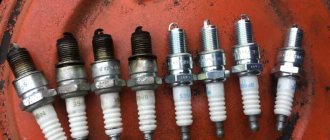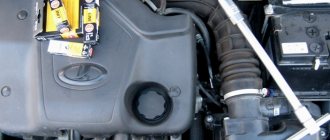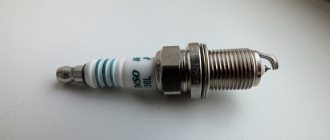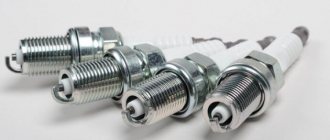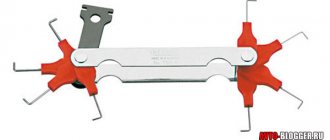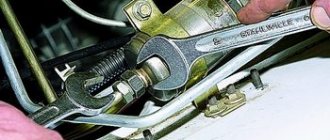Since my Kalina’s mileage has long exceeded 30,000 km, I decided to replace the factory spark plugs with new ones, although, to be honest, the factory ones still felt fine. In cold weather it started up to -20 the first time, and if the thermometer dropped even lower, then the second time. At idle, of course, the tachometer needle floated a little, but it was barely noticeable to the eye. In short, we could still drive, but since it is written in the Murzilka - change it after 30,000 km, then we will follow its instructions and recommendations.
It didn’t take long to choose a company, since most car owners speak quite well about NGK spark plugs, and the main thing here is not to run into a fake. If you have a 16-valve Lada Kalina, then you need to take NGK No. 11, and if you have a regular 8-valve engine, then No. 13. I’ll describe the whole procedure a little, maybe this information will be useful for girls or beginners.
The procedure for replacing spark plugs on a Lada Kalina:
Before this procedure, it is advisable to wipe everything well and clean it from possible oil stains or dust so that no debris gets inside the cylinder. Now we need either a spark plug wrench or a 21mm long socket.
We remove the wires one by one, you will have to make a little effort, since they fit quite tightly.
Personally, my electrode condition was normal, there were no deposits, oil film or soot on them, the only thing was that there was a reddish coating. And this is also not very good and indicates that the fuel with which I fueled my Kalina contained iron-containing additives, the so-called ferrocenes. This can lead to misfire, loss of power and increased fuel consumption.
When we screw in new spark plugs, it is best to first tighten them by hand, and only then use a wrench. Although, it is quite difficult to mix up the wires! But I remember an incident with my father’s VAZ 2112 16-valve, when we put the wires on incorrectly and started the car - it worked like a tractor, all the cylinders were out of tune. After you have installed a new spark plug, put on the wire and carry out exactly the same operation with the remaining cylinders!
That's all! Tighten it better so that no air is allowed to pass through, otherwise over time the spark plug may tear out along with the thread, then you will have to spend another certain amount of money on repairs, but do you need it? At the end of my topic, I would like to arrange a short survey about who uses which companies, besides NGK, and what are their impressions? Let's discuss in the comments below!
Replacing spark plugs is an important procedure that is performed every 30 thousand km or in case of their malfunction. The reason why spark plugs are replaced unscheduled may be unstable engine operation, excessive fuel consumption or poor engine starting. In addition, poor throttle response or when the engine stalls can be evidence of faulty spark plugs. You can even determine the condition of the spark plugs by external signs; below I will give a table by which you can decide whether you need to replace the spark plugs or not.
Today I will talk about how to replace spark plugs on a VAZ 2170, 2171, 2172 (Lada Priora 16 valve)
Before you start replacing, take care of new spark plugs, choose one you like from the options in the auto store.
Replacing spark plugs on a Lada Priora is impossible without a special 16″ socket wrench with an extension. There must be a magnet in the spark plug wrench or head so that the spark plugs can be held suspended.
Possible breakdowns and their causes
There are many reasons why spark plugs can fail. This can happen due to contamination with oil or carbon deposits, destruction of the insulator, mechanical damage, rupture of the jumper, etc. Realistically, you can only deal with pollution. In all other cases, you will have to think about replacing the part.
There are three main cleaning methods: boiling method, sandblasting method and ultrasonic cleaning method. Due to the fact that ultrasonic cleaning requires specialized equipment, we will focus on the two remaining methods.
Digestion method
The essence of this method is that you need to boil the candles in water with washing powder for an hour. This method will allow you to clean the part from dirt without damaging the housing. It is worth noting that after cleaning they produce an unstable yellow spark, which can cause problems at high speeds.
Replacing spark plugs for cars Kalina, Kalina2
Replacing spark plugs is required during routine vehicle maintenance, or if the spark plugs are damaged by low-quality gasoline. It is also useful to replace spark plugs when preparing your car for the winter season. And even if you can’t start your car in winter, replacing spark plugs with dry and warm ones can help.
The easiest way to replace spark plugs is on an eight-valve engine. The spark plugs are open and easily accessible - just open the hood of the car. You will need a spark plug wrench. The most common keys are tubular in shape. A key with a cardan and a cross handle is not for everybody. With such a key it is difficult to unscrew the candle, but even when you turn it, you will not overtighten it.
Change spark plugs when the engine is cold. If you can't unscrew them, use a trick. Warm up the engine and remove the spark plugs from their place, and replace them an hour later when the engine has cooled down.
In addition to the spark plug wrench, you will need something with which you will rotate the wrench - a screwdriver or bit. It is advisable to have a spare screwdriver with you. Open the hood of the car and, after removing the tip from the first spark plug, unscrew it. Set aside. Before screwing in a new spark plug, run a simple pencil along the thread several times - after a year this will help you unscrew the spark plug. Screw in and tighten the spark plug. Attach the end of the high-voltage wire. When tightening the candle, do not overdo it. Never use pipes, levers or other torque amplifiers. The O-ring should deform slightly, but not flatten into a washer.
By consistently unscrewing and screwing in the spark plugs, you will not mix up the high-voltage wires. Place the old candles in a row. When you're done, look at them. If the candles are covered with a light, dense, gray coating, everything is in order. Soot - indicates incomplete combustion of gasoline. You need to go to a service station and look for a fault in the control system. Black oil deposits are a sign of oil penetration. If one of the spark plugs is perfectly clean and the rest are sooted, antifreeze gets into the cylinder, removing and milling the cylinder head is required. Red flakes of ferrocenes will show you that you need to change the dressing.
How often do you need to ignite?
The standard frequency of replacing spark plugs on a VAZ can vary quite widely - from 30 thousand kilometers for regular (standard) ones and up to 80 thousand for modern iridium and platinum ones. As with any other consumables, fluctuations are possible, the main factors influencing which are the condition of the engine and ignition system, the quality of the fuel and the nature of the vehicle's operation. For example, if you often drive short distances around the city, then even if all car systems are working normally, the spark plugs usually become covered with black soot quite quickly, since they do not reach the required temperature for self-cleaning.
It's better to do this visually. If you find only slight darkening and a small grayish-yellow or pale brown coating on dry electrodes that have not lost their shape, you can safely return the spark plugs to their place and drive on.
If a significant coating of black or white or a shade of rust is detected, oiling is already a reason to think about replacing them or at least cleaning them. Cleaning can be done by soaking the spark plugs in gasoline or a special liquid and carefully removing the deposits with a brush or fine sandpaper. In this case, be sure to check the spark plug gap between the electrodes using feeler gauges. It will almost certainly be different from the recommended 1-1.1 mm. To continue operation, it must be restored by carefully bending the side electrode. But keep in mind that this is more of a temporary measure, after which the period for replacing spark plugs will pass much faster than with new ones.
It is better to throw away electrodes if they:
- Heavily contaminated
- Lost form
- Melted
- Broken off
- Has damage to the insulator
By the way, this condition is usually a direct indication of the presence of more serious problems, or the car owner’s reluctance to carry out maintenance on time. Like all other consumables, it is better to change candles regularly and in a timely manner. But what are the best spark plugs for Kalina?
Today, many people install gas-cylinder equipment on their cars, since driving on gas is much cheaper and more profitable than driving on gasoline. The following spark plugs are suitable for such cars:
- French BERU Ultra 14R-7DU, they are not quite designed for gas, but still suitable;
- Ukrainian Plazmofor Super GAZ have good quality, but are inferior to imported ones;
- Czech Brisk LPG LR15YS Silver, the electrode of which is made of silver. They are cheap but non-toxic.
- German Bosch Platinum WR7DP - they have a thin electrode and an original design;
- Japanese NGK LPG LaserLine are quite expensive, but non-toxic and economical.
In general, there are a large number of them, the main thing is to choose models with thin electrodes for gas.
How to get rid of unnecessary details
Any 16-valve engine has a plastic protection installed on top. But the protective cover can always be removed by simply pulling the part up. By the way, the rubber supports on the covers of motors 21126 and 21127 will be the same (see figure).
It is recommended to unscrew the filler plug, but you can leave it in place. The lid must be pulled up, snapping off the supports one by one.
Everything looks more complicated than it actually turns out to be. Try it!
Actions before replacement
First of all, we recommend disconnecting the negative terminal of the battery. To do this you need a key “10”. Then disconnect the ignition coil connectors. The appearance of one connector is shown below.
By pressing the latch, the connector is pulled up
Next, taking a TORX E-8 wrench, unscrew the screw securing the coil.
Need a TORX spanner
The coil itself can be pulled out by holding it by the connector body.
The connector will not break, try it
Finally, the engine is ready to replace the spark plugs. This process is discussed further.
Do not allow dust to get into the spark plug well! If necessary, you can use a can of compressed air.
We change the spark plugs ourselves
Let's say all the wells were open, and now you can see the contacts of the spark plugs.
Only one well is open here
Taking a high 16 socket wrench, dismantle each spark plug. It is better to use a special tool - that is, a “spark wrench”.
All spark plugs should come out easily
Installation is carried out in the reverse order, but the following requirements are observed:
- First, taking the spark plug body with your hands, screw it in without using a key;
- The key must be rotated with a force of 25–30 N*m. Do not exceed these numbers!
It is usually recommended to change spark plugs “one at a time”. This advice will be useful for beginners.
If there is oil inside the wells, you need to “get it wet”. The oil itself will not cause harm, but sand and dust will get into the cylinders with it.
Selection of components
Symptoms of incorrectly selected spark plugs:
From the factory, “AU17DVRM” spark plugs will be installed on any VAZ 16-valve engine. They are produced in Saratov under license from BOSCH. There are also two complete analogues recommended by VAZ: DR15YC-1 (BRISK), as well as FR7DCU (BOSCH).
Products
In winter, you can switch to a lower heat rating - “AU14DVRM” candles are suitable. All analogues are presented in the table.
Hi all. Today we will replace spark plugs on a second generation Lada Kalina with a sixteen valve engine.
I recommend buying Denso candles. Inexpensive and go from replacement to replacement without problems. Order number: Q20PR-U11 .
To replace spark plugs you will need:
- open-end wrench for ten
- seven-head wrench
- a long spark plug wrench because the wells are deep
Which spark plugs are best for an 8-valve Kalina
AvtoVAZ recommends several options for spark plugs.
- A17DVRM - original number. A27DFID is a more modern analogue, and according to reviews it is better. The cold start problem goes away.
The most budget option is spark plugs A27ДМРВ produced by JSC Robert Bosch Saratov.
- German candles from the company BERU–14R-7DU ;
- Japanese NGK–BPR6ES (very frequent replacement, good spark plugs according to reviews);
Candles NGK–BPR6ES in branded packaging in bright colors.
- Another Japanese company is DENSO W20EPR ;
- CHAMPION (England) – RN9YC ;
- From the Czech company BRISK you should take a closer look at the article number LR15YC ;
- BOSCH (Germany) – WR7DC .
- NGK – BPR6EIX11 ;
- DENSO – IW20TT .
Iridium spark plugs
Step by step replacement
1. First, disconnect the negative terminal of the battery. Ten key nut.
2. Remove the engine protective cover. We just pull it towards ourselves.
3. Using a socket head, unscrew the fastenings of the ignition coils. Each coil is secured with one bolt.
Ignition coil bolt locations.
4. Remove the power connectors from the coils. On the connector, press the latch with your thumb and pull it towards you.
5. Take out the coils. They fit tightly, so you need to apply some force.
We stack the coils so that we remember where each one was. During assembly you need to install it as it was.
6. Unscrew and change the spark plugs. I advise you to change one spark plug at a time. That is, they unscrewed one spark plug and screwed in a new one.
If you unscrew all the spark plugs at once, there is a chance that debris will get into the wells.
We tighten the candles without fanaticism.
7. Insert the coils all the way and tighten them with bolts.
8. Connect the connectors and battery terminal.
9. Put on the motor cover.
There are four grooves on the cover, and four matching holes on the motor. Just put the grooves into the holes and press.
2302-3-2-09-06 (Copy)
When installing the spark plug, you must screw it in by hand to avoid damaging the threads of the spark plug hole in the cylinder head.
If the spark plug does not follow the thread, strong resistance to rotation will be felt. In this case, it is necessary to completely unscrew the spark plug and, after cleaning the threads, re-tighten it.
Finally tighten the spark plug to a torque of 25–30 N. m.
Attention! Over-tightening the spark plugs can damage the threads in the spark plug holes in the cylinder head.
We replace the remaining spark plugs in the same way.
On an 8-valve engine
2279-4-12-02 (Copy)
When installing the spark plug, you must screw it in by hand to avoid damaging the threads of the spark plug hole in the cylinder head.
If the spark plug does not follow the thread, strong resistance to rotation will be felt. In this case, it is necessary to completely unscrew the spark plug and, after cleaning the threads, re-tighten it.
Finally tighten the spark plug to a torque of 31–39 N. m.
Attention! Over-tightening the spark plugs can damage the threads in the spark plug holes in the cylinder head.
The manufacturer prescribes replacing spark plugs on the Lada Kalina every 30 thousand km.
Replacement of spark plugs must be carried out only on a “cold” engine!
Instructions for cars with a 16-valve engine:
- Using an upward motion, remove the plastic casing from the engine.
- Press the latch and disconnect the block from the ignition coil connector.
- Using the E8 head, unscrew the screw securing the ignition coil.
- Remove the coil from the spark plug well.
- Using a spark plug wrench or a 16 mm socket, remove the spark plug from the well.
- Install a new spark plug into the spark plug well and screw the spark plug in by hand.
- Tighten the spark plug with a force of 25–30 N.m.
NGK vs Brisk: experiment with increasing spark plug gap
A couple of months ago I wrote a topic about replacing spark plugs on my Kalina. Instead of the factory ones, Brisk decided to try another manufacturer, namely NGK, there were too many positive reviews about them. As always, I bought a set of spark plugs from BB and replaced them. I did not set the gap, since the manufacturer assures that everything is already set for ideal engine operation.
After the replacement, no more than 1000 km passed and the first cylinder began to break through, this was especially noticeable at idle speed, when sharp dips in engine operation were felt. I opened the hood and saw that the spark plug had burst all around, which I previously wrote an article about. If you are interested, you can search in this section, there is a photo there. And instead I decided to put back the factory Birsk, which, although it was already red from long-term use, worked perfectly.
Since it’s almost summer outside now, the usual bubbling and diesel noise of a 1.6 8-valve engine should, in theory, not be present, especially on a warm engine. But on my Kalina, for some reason, this bubbling noise was present even on a well-warmed-up engine, although this was not observed before installing NGK spark plugs. So today I decided to unscrew them and look at their condition. In appearance, everything was fine with them, but then I noticed that the gap on the factory Brisks was larger. I took out old spark plugs from the glove compartment and decided to use them to set the same gap on my NGKs. Pay attention to the photo below:
On the left are the factory Brisks, and on the right are the new NGKs
After doing this work, I decided to start the car and try to warm it up to operating temperature in order to evaluate how much the new gap affected engine performance. I drove to a gas station about 20 km from the city. And this is the conclusion I can draw:
- Diesel production stopped when the engine was fully warmed up.
- The engine sound has become quieter, especially when idling.
- I was pleasantly surprised by the fuel consumption. If with a small spark plug gap it was 5.8 - 6.2 liters, then after increasing it to the factory Brisk, it became 4.8 - 5.2. Tested at a speed of 90 km/h. Moreover, during today's tests there was wind.
I concluded for myself that you should not blindly trust the manufacturer and it is better to set the required gap yourself and experiment a little, changing everything up or down. NGK brand products have now become even more wary, since this is already the second case with negative consequences.
ladakalinablog.ru

